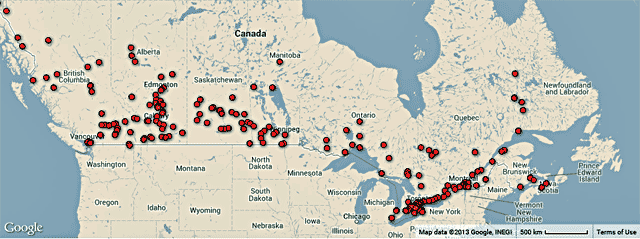|
Click to view a CBC created interactive map.
3 December 2013
Runaway Trains Almost
Triple Reported Rate
Canada - Two Decembers ago, a train rolled uncontrolled for 24 kilometres, reaching a speed of 100 kilometres an hour before eventually
coming to a stop near the eastern Quebec town of Sept-Iles.
Five months earlier, 33 CN cars escaped from a yard near Edmonton and travelled more than five kilometres onto a line carrying residues of gasoline, diesel
fuel, and sulphuric acid in their tanks.
Cases like these, referred to technically as runaway rolling stock, happen on average 35 times a year, far more often than previously thought, CBC News has
learned after examining a railway database kept by the Transportation Safety Board (TSB).
After this summer's Lake Megantic tragedy, in which 47 people died when a parked train that was insufficiently secured ran down a hill derailing and
exploding, there have been calls for increased scrutiny of rail safety, including in last week's auditor general's report.
Until now, TSB annual reports from 2000 to 2012 only identified 158 runaways, counting an incident as a runaway only when it was the primary issue reported to
safety inspectors.
But CBC News analyzed the complete TSB rail database of so-called incidents and accidents obtained through access-to-information and discovered that runaways
have been involved in more than 300 other cases.
"This is news to me," said David Jeanes, head of Transport Action Canada, a rail-safety consultancy, who regularly reads the TSB's annual
reports.
Few Runaways Investigated
Instead, the majority of runaway train cases remain unreported publicly because they are categorized instead as derailments or collisions, without any
indication that the train was rolling away uncontrolled at the time.
"If a runaway causes derailment or collision, it will be reported as this higher consequence occurrence," said TSB spokesperson Rox-Anne
D'Aoust.
For example, the Lake Megantic tragedy, when 74 crude-oil laden cars ran unmanned down the tracks into the community of 6,000, wouldn't be counted among the
publicly reported runaways based on the TSB definitions.
A look at the unreported runaways reveals that not only are railway cars improperly or inadequately secured in yards, but trains, including those with
passengers, have separated while in transit.
Oftentimes, the cars don't collide with other trains, derail, or cause deaths, but they raise questions about the ability to secure railway cars in
place.
But only nine of the 459 runaway-related occurrences, or about two percent, have been fully investigated by the TSB, the independent agency charged with
finding ways to make the rail industry safer.
"Looking at incidents is one thing that helps you prevent accidents," said Jeanes, saying more of the smaller issues should be examined.
Jeanes notes that the TSB recently pleaded with Transport Canada, the federal rail regulator, to take faster action to implement their recommendations to help
fix some of the issues.
The TSB's D'Aoust said she couldn't comment directly on why only nine of the 459 runaways were investigated, but she says they depend on the experience of the
TSB's 18 investigators across the country to determine what type of incident could produce the most worthwhile recommendations.
Flammable Corrosive Freight
The database turns up a number of runaway near-misses that haven't been publicly reported:
- A VIA Rail engineer had to bring his train to a stop to avoid hitting a runaway gondola car up ahead near Breslau, Ontario,
16 Aug 2009;
- Two CN freight cars, including one containing the highly flammable chemical vinyl acetate, rolled for 10 kilometres along a heavily travelled main track
near Longueuil, Quebec, 18 Jan 2005;
- A CN freight train lost more than 300 metres of cars that ran uncontrolled before coming to a stop near Huntsville, Ontario,
28 Jan 2004;
- Two CN cars full of corrosive anhydrous ammonia ran uncontrolled onto the main line from Port Robinson near Niagara Falls, Ontario, until a citizen
spotted the cars and reported them, 19 Aug 2001.
Runaways have also led to the deaths of at least five railway workers during the 13-year period, four of which happened in mountainous B.C.
In fact in one area of the Kootenay mountains in Trail, B.C., there have been three runaways from 2002 to 2007 along CP rail lines.
They've included unmanned trains careening down the mountains with cars loaded with anhydrous ammonia and sulphur dioxide and travelling through areas at more
than double the maximum speed of 30 kilometres an hour.
In a 2007 case in that area where the train was occupied, three crew members tried to control the train but its brakes sent up a cloud of smoke.
Two of the employees jumped for their lives, while the third, 51-year-old engineer Lonnie Plasko, was found dead in the derailed locomotive.
Dieter Bogs, the mayor of Trail, B.C., recalls that 2007 derailment tragedy but was surprised to learn from CBC News about two previous runaways in his
community that involved dangerous goods.
"I'm not very happy about that," Bogs said, adding that both he and emergency responders in the area need to know about runaways, even if the trains
don't derail.
"It's important because we have to have the systems in place to respond to that," said Bogs.
"It's absolutely important that we know that the people in our community are not going to be subject to the same incident that took place in
Quebec."
British Columbia ties with Quebec for the third highest number of runaway cases from 2000 through 2012, with 73 incidents each.
Ontario leads with 124, followed by Alberta's 101.
Trains Roll Across Border
Another surprising revelation from the database is that two freight cars have rolled unmanned across the border from U.S. yards into Canada, one from Norton,
Vermont, in 2010 and another from Niagara Falls, New York, last year.
In the 2010 incident, a boxcar full of paper from Vermont travelled 50 kilometres on its own, undetected by Canadian border agents and the railway, coming to
rest near Lennoxville, Quebec.
"The car reached high speeds and crossed several public crossings," says the TSB database record from the St. Lawrence and Atlantic Railway, though
it adds that no dangerous goods were involved, and no injuries or derailment reported.
"That stretch of rail is a dark area (with no electronic monitoring) so we had no way of detecting it," Mario Brault, president of the small railway
that operates between Montreal and Portland, Maine, told CBC News this week.
"The box car rolled through many road level crossings. Some of them had signals and gates, but some of the crossings were unprotected," he said,
acknowledging the potential of a collision with cars or trucks at the crossing.
Employees of the company were disciplined for not securing the car with enough brakes.
Almost a quarter of the 459 runaway occurrences in the past 12 years involved dangerous goods.
Although many of them are contained to railway yards, the runaways can lead to collisions with other trains, as happened in 2011 in Prince George, B.C., when
CN tank cars full of diesel fuel, sodium chlorate, and sulphuric acid hit another train in the yard.
Incidents Largely Minor: CN
Mark Hallman, a spokesmen for CN, said the instances of CN trains and or rail cars running uncontrolled "are important leading safety indicators of which
CN is cognizant, takes seriously, and continually addresses through its safety practices."
But Hallman added that the vast majority of such incidents are minor, slow speed switching accidents in CN rail yards.
To try to combat the problem, Hallman says train crews are given specific charts on how many hand brakes to use, based on the weight and gradient of an
incline.
So-called derails are placed at the edges of yards to stop uncontrolled cars from entering main tracks, noted Hallman.
A CBC News examination of the rail database includes examples where the derails have not worked.
Interestingly, railway cars were sometimes moved by high winds.
Ed Greenberg, a spokesman for CP, said they take safety seriously and notes that the company has "changed a lot over the years with proactive steps to
enhance safety through the communities in which we operate, including further developing information-sharing with local officials."
VIA Rail acknowledges eight cases since 2000 where their passenger cars have run away.
VIA spokesperson Jacques Gagnon told CBC News each incident was a temporary break away where passenger cars uncoupled from a locomotive triggering, automatic
emergency brakes which he says safely stopped the cars.
In five of the cases passengers were on board the trains, some of which were travelling at high rates of speeds, when the emergency brakes kicked
in.
Three incidents happened in a rail yard.
Gagnon says there was only one minor injury in all of the VIA cases.
Author unknown.
|


